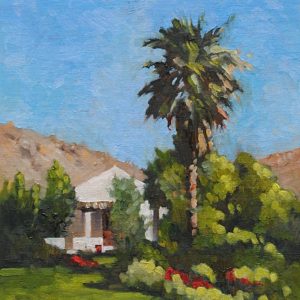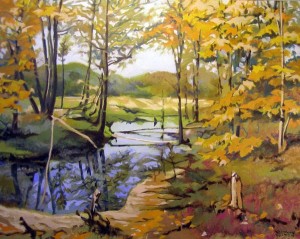Dear Artist,
Before 1956, Desmond Morris was a surrealist painter who had recently completed a doctorate in zoology at Oxford. That year, he began studying the picture-making abilities of two-year old chimpanzee Congo, a resident at the London Zoo. As Morris had recently agreed to host a show on animal behavior for Granada TV, he caught the whole thing on film.
Morris put a pencil in Congo’s hand and quickly surmised that the chimp was making aesthetic decisions. For example, Morris gave Congo a card with a square drawn in the middle and noticed that he began his mark making in the centre of the square, then would shoot lines out of the square, then obliterate the square. Congo also drew circles and balanced off-centre compositions. When Congo switched to paint, his work took on an expressionist energy and became organized into a radiating fan pattern. Soon, like most toddlers, Congo was classified as a lyrical abstract impressionist. Within a year, though, he’d sold out a show at the Institute of Contemporary Arts in London.
If you’re wondering if Congo was a bit of an outlier, Morris studied the creative habits of many of the chimpanzees at the zoo, and Congo’s development stood out. Chosen at first for his boisterous personality, Congo began with scribbly lines and splotches but his compositions soon matured into crafted ones — what artnet writer Taylor Defoe recently described as demonstrating “a formal logic without having an obvious analog to the real world. Just as Pollock, de Kooning, and Kline were exploring the limits of pictorial abstraction, so too was a three-year-old chimpanzee.” Morris and Congo’s discoveries were collected in Morris’s seminal 1967 book The Naked Ape: A Zoologist’s Study of the Human Animal. Congo died from tuberculous in 1964 at age 10.

Four-stage Painting, Executed between 10 – 12th August, 1957
charcoal and paint on paper
32.1 x 43.8 cm
by Congo
Sincerely,
Sara
PS: “They’re actually very good.” (James Mayor, director of the Mayor Gallery, London)
Esoterica: After his 1958 sell-out at the ICA, Congo continued to paint and would crank out over 400 drawings and paintings over three years. Picasso hung one in his studio. So did Miró and Dali and the Duke of Edinburgh got one, too. And in 2005, over 40 years after his death, a few of Congo’s paintings appeared in an auction at Bonhams — alongside works by Renoir and Warhol — and sold for stratospherically higher than their estimates of £600. This coming winter, the last of Congo’s oeuvre will be shown in an exhibition at The Mayor Gallery in London after Morris, now 91, has decided to release all but one from his original collection. “It’s now more than a scientific experiment,” Morris says. “It has now become a bit of art history.”
“Something strange was coming out of the end of the pencil. It was Congo’s first line. It wandered a short way and then stopped. Would it happen again? Yes, it did, and again and again.” (Desmond Morris, 1957)
Sara Genn: New Alphabet is on view until October 17th, 2019 at Dimmitt Contemporary Art, 3637 West Alabama Street, Houston.
The Letters: Vol. 1 and 2, narrated by Dave Genn, are available for download on Amazon, here. Proceeds of sales contribute to the production of The Painter’s Keys.
“Success has to do with deliberate practice. Practice must be focused, determined, and in an environment where there’s feedback.” (Malcolm Gladwell)
Featured Workshop
Join Canadian artist Sheree Jones as she shares her passion for painting “from life” at this idyllic coastal retreat.
This workshop is designed for experienced beginner & intermediate oil (and acrylic) painters.
The small group size guarantees plenty of one on one instruction.
While you’re busy creating art, your friendly hosts at Casa Buena will be working hard, ensuring that your stay is a memorable one.
Outstanding food, accommodations, and field trips will satisfy your desire for both comfort and adventure. Non painting partners welcome.
For more information visit:
http://www.casabuenaartretreat.com/retreatSheree.htm
or contact Sheree:
sheree@shereejones.com
Featured Artist
My statement is pretty short. I love all kinds of paintings and I think Robert Genn is Canada’s finest painter. A great feature of his work are his designs — so beautifully conceived.









15 Comments
“Just as Pollock, de Kooning, and Kline were exploring the limits of pictorial abstraction, so too was a three-year-old chimpanzee.” – Couldn’t have said it better myself.
You took the words right out of my mouth.
I like the way he holds the brush. It’s not hard to imagine it was the kind of work that is based in fun. Thanks, Sara
Good grief. You’ve have to be kidding .
I have been writing this morning about the value in listening for different stories rather than TO stories. The first orientation of listening FOR stories requires that we momentarily set aside all that we know about organizing and understanding our world and we listen as if we are learning for the first time – because we are. The notion or request comes from Annie Ned when she spoke in 1982 at a conference in Haines Junction, Yukon of Canada. What Annie Ned doesn’t mention is how brave we must be to listen FOR stories and how willing we must be to appear foolish and incompetent and possibly even ridiculous – mostly to ourselves but this self-view has powerful regulators on our behaviour. Your post Sara is a perfect time to listen FOR different stories. Thank you!
*Annie Ned was awarded the Order of Canada in 2003 in part for her contributions to documenting history in the southern Yukon Territory. ( “Listening for Different Stories” by Julie Cruikshank in The Nature of Canada edited by Colin M. Coates and Graeme Wynn , 2019)
Love this!
An APE as arbitrary arbiter of abstract ART….
AND who benefits from Congo’s sold out shows and auction profits?
You GO Morris….surrealism at it’s finest!
We have repeatedly over estimated the differences between ourselves and other animals. I understand the above comments, but a larger question is why do we assume animals don’t have an esthetics sense?
While I do not believe in humanity as an evolutionary “upgrade” from an ape, I do believe that animals have aesthetic sensitivities like us. My Thoroughbred stallion loved instrumental classical music, moving in and hanging his head as close as possible to my boom box when it was played. He displayed dislike for opera and rock by going as far away from the source of the sound as possible. My Rhodesian Ridgeback dog also loves instrumental classical and film music, and flamenco guitar. She consistently leaves the room if I put on other kinds of music. I remember seeing videos of the elephant at the LA Zoo working with acrylic paint making abstract images. She seemed to genuinely enjoy playing with the materials. To me, all of these behaviors signal intelligence well beyond basic survival instinct. Fun stuff!
I create high realist oil paintings as well as acrylic abstracts. And teach everything in between. I will imagine that those who dismiss Congo’s paintings do not accept the abstract as art–even though it has been a major visual arts force since the turn of the last century. Personally I think Congo’s paintings are charming and lovely. And quite acceptable and engaging as art, even if not created by human hand/mind.
I think I can learn something from this artist :) – thank you Sara!
What a fabulous story. Sara, I always learn such interesting things from your writing. Once again, thank you!
What an incredible story. I had no prior knowledge of Congo and his ability to create art works. I love the photo of him sitting with a brush in hand dipping it into some paint while his left hand is on the paper……much like a child would do sitting there very engrossed in what he’s doing. WOW……Thank you so very much for sharing this moving article about Desmond Morris and his journey with Congo.
It is sad and infuriating that people will pay more money for a “painting” done by an ape or a child than they will for one done by a qualified m talented unknown artist! And that you are perpetuating the idea is even more infruiating!
While hiking in the hills of northern California sheep country, I came to a fork in the trail used by the sheep, and took a left, which led to a magnificent and restful spot above the gorge and river hundreds of feet below. I could only conclude that it was their scenic spot, since the trail continued on back to the main route, and the ranch.